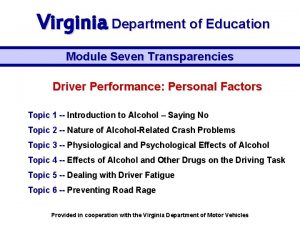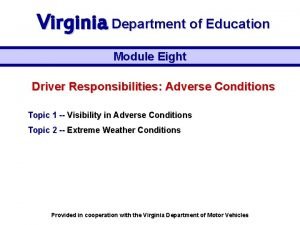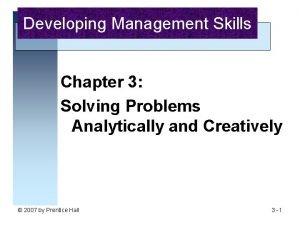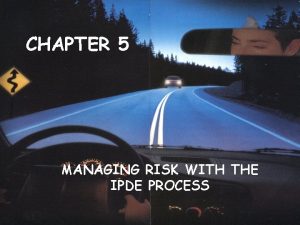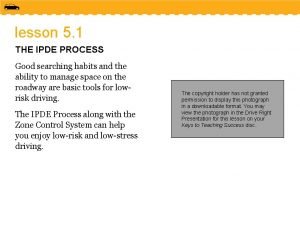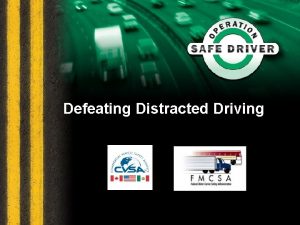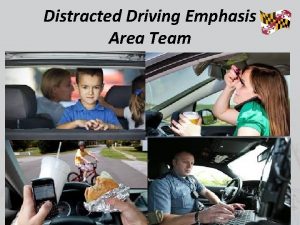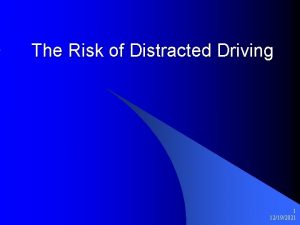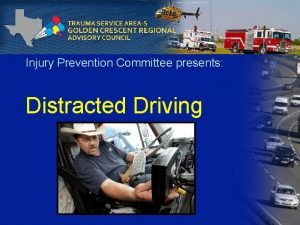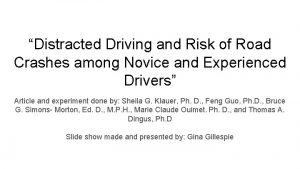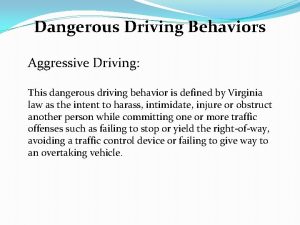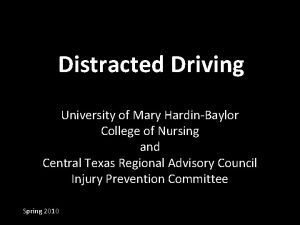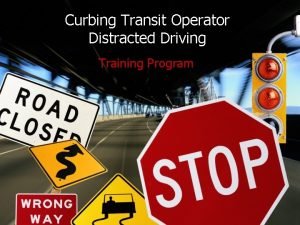The Risk of Distracted Driving 1 11232020 Complacency

















- Slides: 17

The Risk of Distracted Driving 1 11/23/2020

Complacency Kills is the old saying. Then why aren’t you wearing your seat belt and watching your speed? 2 11/23/2020

What are the safety precautions to be followed prior to and during driving? Seats l Radio l Gas l 3 11/23/2020

What distance will your vehicle travel before it comes to a complete stop at 70 mph? Reactionary Distance l Braking distance l Total Distance l 4 11/23/2020

What is Reactionary Distance and how much time does it consume? Table II—Stopping Distance in Feet Vehicle speed Service brake in miles per PFC 0. 9 hour (1) 20 32 25 49 30 70 35 96 40 125 45 158 50 195 55 236 60 280 Emergency brake PFC 0. 9 PFC 0. 9 (2) 35 54 78 106 138 175 216 261 310 (3) 32 45 65 89 114 144 176 212 250 (4) 35 54 78 106 138 175 216 261 310 (5) 38 59 84 114 149 189 233 281 335 (6) 30 43 61 84 108 136 166 199 235 (7) 83 123 170 225 288 358 435 520 613 (8) 85 131 186 250 325 409 504 608 720 (1) Loaded and Unloaded Buses. (2) Loaded Single-Unit Trucks. (3) Loaded Tractors with Two Axles; or with Three Axles and a GVWR of 70, 000 lbs. or less; or with Four or More Axles and a GVWR of 85, 000 lbs. or less. Tested with an Unbraked Control Trailer. (4) Loaded Tractors with Three Axles and a GVWR greater than 70, 000 lbs. ; or with Four or More Axles and a GVWR greater than 85, 000 lbs. Tested with an Unbraked Control Trailer. (5) Unloaded Single-Unit Trucks. (6) Unloaded Tractors (Bobtail). (7) All Vehicles except Tractors, Loaded and Unloaded. (8) Unloaded Tractors (Bobtail). PFC = Peak Friction Coefficient 5 11/23/2020

What distance does your vehicle travel at 20, 40, 60, 70, and 100 mph? l l l l Have you ever thought about that distance? Formula 1. 466 x your speed = feet per second 20 mph = 29. 32 feet per sec. 40 mph = 58. 64 feet per sec. 60 mph = 87. 96 feet per sec. 70 mph = 102. 62 feet per sec. 100 mph = 146. 6 feet per sec. So every 4 seconds at 60 mph you have traveled 351. 84 feet over the length of a football field. Keep 4 seconds in mind for later. 6 11/23/2020

Why is it important to know the distance you are traveling? l l l It enables us to be more effective at threat evaluation, stopping distance, collision avoidance, etc… At 20 mph you are traveling 29. 32 feet per second and it takes you. 75 of a second to react how much distance have you covered? 15 feet at 20 mph, the child stepped out at the front of a car and you were 1. 5 car lengths away when the child stepped out are you able to stop prior to hitting the child? 7 11/23/2020

How far in front of your vehicle do the vehicle’s low beams project out on an average? l So we stated earlier that a vehicle moving 70 mph travels 102. 62 feet per second. On a good day your lights project out between 150 to 200 feet, doesn’t leave much time if something bad happens. So if you are on the low end 150 feet and you are moving 102. 62 feet per second there is only about 47 feet left to react in, is that enough. 8 11/23/2020

How far in front of your vehicle do the vehicle’s high beams project out on an average? l So we stated earlier that a vehicle moving 70 mph travels 102. 62 feet per second. On a good day you lights project out between 250 to 300 feet, doesn’t leave much time is something bad happens. So if you are on the low end 150 feet and you are moving 102. 62 feet per second there is only about 47 feet left to react in, is that enough. 9 11/23/2020

What is the most common night time driving error? l Over driving headlights. 10 11/23/2020

When we are driving how do we receive most of the information that we are processing? Sight l 90% l 11 11/23/2020

How long are your eyes off the road when you are texting? (Average time) 4. 3 to 4. 6 seconds l Type of driving is distracted driving l List other distractions in the vehicle l 12 11/23/2020

So we stated earlier that a vehicle moving 70 mph travels 102. 62 feet per second. If your eyes are off the road for just 4. 3 seconds you have traveled 441. 26 feet. That is almost 1 and ½ football fields. That is a long time for something to happen. We all have done it. 13 11/23/2020

If you are involved in collision avoidance where should you be looking? l Where you want the vehicle to go. 14 11/23/2020

Where should we be steering during collision avoidance most of the time? l Where you want the vehicle to go and usually at where the obstacle is coming from vice where it is going. 15 11/23/2020

Summary This is a class that could take up to 40 hours to teach with Non Emergency Vehicle Operations Practical’s. This class is designed to get you to think about what you and your vehicle are doing while on the road. 16 11/23/2020

Questions? Comments? 17 11/23/2020
 Module 7 topic 5-6
Module 7 topic 5-6 Module 7 topic 1 distracted driving
Module 7 topic 1 distracted driving Chapter 8 great gatsby vocab
Chapter 8 great gatsby vocab Constancy commitment compression complacency
Constancy commitment compression complacency Complacency jelentése
Complacency jelentése Constancy commitment compression complacency
Constancy commitment compression complacency Linguistic complacency
Linguistic complacency Chapter 25 complacency and change
Chapter 25 complacency and change Distraction noun
Distraction noun Credit risk market risk operational risk
Credit risk market risk operational risk Ipde examples
Ipde examples Chapter 1 managing risk when driving
Chapter 1 managing risk when driving What are the four steps of the ipde process?
What are the four steps of the ipde process? Business risk audit
Business risk audit Ar = ir x cr x dr
Ar = ir x cr x dr Relative risk and attributable risk
Relative risk and attributable risk Risk financing transfer dan risk retention
Risk financing transfer dan risk retention Risk projection
Risk projection
